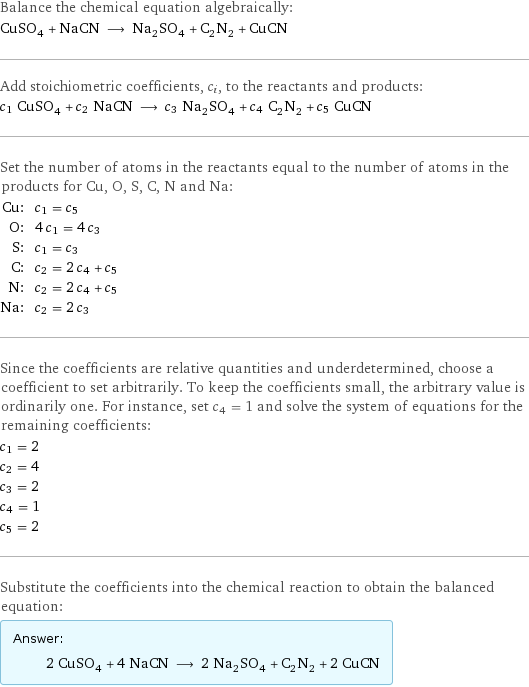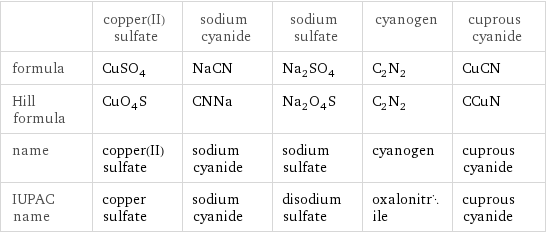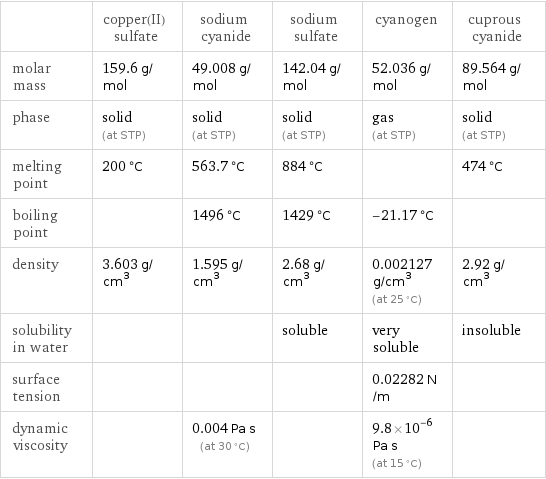Input interpretation

CuSO_4 copper(II) sulfate + NaCN sodium cyanide ⟶ Na_2SO_4 sodium sulfate + C_2N_2 cyanogen + CuCN cuprous cyanide
Balanced equation

Balance the chemical equation algebraically: CuSO_4 + NaCN ⟶ Na_2SO_4 + C_2N_2 + CuCN Add stoichiometric coefficients, c_i, to the reactants and products: c_1 CuSO_4 + c_2 NaCN ⟶ c_3 Na_2SO_4 + c_4 C_2N_2 + c_5 CuCN Set the number of atoms in the reactants equal to the number of atoms in the products for Cu, O, S, C, N and Na: Cu: | c_1 = c_5 O: | 4 c_1 = 4 c_3 S: | c_1 = c_3 C: | c_2 = 2 c_4 + c_5 N: | c_2 = 2 c_4 + c_5 Na: | c_2 = 2 c_3 Since the coefficients are relative quantities and underdetermined, choose a coefficient to set arbitrarily. To keep the coefficients small, the arbitrary value is ordinarily one. For instance, set c_4 = 1 and solve the system of equations for the remaining coefficients: c_1 = 2 c_2 = 4 c_3 = 2 c_4 = 1 c_5 = 2 Substitute the coefficients into the chemical reaction to obtain the balanced equation: Answer: | | 2 CuSO_4 + 4 NaCN ⟶ 2 Na_2SO_4 + C_2N_2 + 2 CuCN
Structures

+ ⟶ + +
Names

copper(II) sulfate + sodium cyanide ⟶ sodium sulfate + cyanogen + cuprous cyanide
Reaction thermodynamics
Enthalpy

| copper(II) sulfate | sodium cyanide | sodium sulfate | cyanogen | cuprous cyanide molecular enthalpy | -771.4 kJ/mol | -87.5 kJ/mol | -1387 kJ/mol | 306.7 kJ/mol | 96.2 kJ/mol total enthalpy | -1543 kJ/mol | -350 kJ/mol | -2774 kJ/mol | 306.7 kJ/mol | 192.4 kJ/mol | H_initial = -1893 kJ/mol | | H_final = -2275 kJ/mol | | ΔH_rxn^0 | -2275 kJ/mol - -1893 kJ/mol = -382.3 kJ/mol (exothermic) | | | |
Equilibrium constant
![Construct the equilibrium constant, K, expression for: CuSO_4 + NaCN ⟶ Na_2SO_4 + C_2N_2 + CuCN Plan: • Balance the chemical equation. • Determine the stoichiometric numbers. • Assemble the activity expression for each chemical species. • Use the activity expressions to build the equilibrium constant expression. Write the balanced chemical equation: 2 CuSO_4 + 4 NaCN ⟶ 2 Na_2SO_4 + C_2N_2 + 2 CuCN Assign stoichiometric numbers, ν_i, using the stoichiometric coefficients, c_i, from the balanced chemical equation in the following manner: ν_i = -c_i for reactants and ν_i = c_i for products: chemical species | c_i | ν_i CuSO_4 | 2 | -2 NaCN | 4 | -4 Na_2SO_4 | 2 | 2 C_2N_2 | 1 | 1 CuCN | 2 | 2 Assemble the activity expressions accounting for the state of matter and ν_i: chemical species | c_i | ν_i | activity expression CuSO_4 | 2 | -2 | ([CuSO4])^(-2) NaCN | 4 | -4 | ([NaCN])^(-4) Na_2SO_4 | 2 | 2 | ([Na2SO4])^2 C_2N_2 | 1 | 1 | [C2N2] CuCN | 2 | 2 | ([CuCN])^2 The equilibrium constant symbol in the concentration basis is: K_c Mulitply the activity expressions to arrive at the K_c expression: Answer: | | K_c = ([CuSO4])^(-2) ([NaCN])^(-4) ([Na2SO4])^2 [C2N2] ([CuCN])^2 = (([Na2SO4])^2 [C2N2] ([CuCN])^2)/(([CuSO4])^2 ([NaCN])^4)](../image_source/c270bf7674f8a30aef1ad708aa05810f.png)
Construct the equilibrium constant, K, expression for: CuSO_4 + NaCN ⟶ Na_2SO_4 + C_2N_2 + CuCN Plan: • Balance the chemical equation. • Determine the stoichiometric numbers. • Assemble the activity expression for each chemical species. • Use the activity expressions to build the equilibrium constant expression. Write the balanced chemical equation: 2 CuSO_4 + 4 NaCN ⟶ 2 Na_2SO_4 + C_2N_2 + 2 CuCN Assign stoichiometric numbers, ν_i, using the stoichiometric coefficients, c_i, from the balanced chemical equation in the following manner: ν_i = -c_i for reactants and ν_i = c_i for products: chemical species | c_i | ν_i CuSO_4 | 2 | -2 NaCN | 4 | -4 Na_2SO_4 | 2 | 2 C_2N_2 | 1 | 1 CuCN | 2 | 2 Assemble the activity expressions accounting for the state of matter and ν_i: chemical species | c_i | ν_i | activity expression CuSO_4 | 2 | -2 | ([CuSO4])^(-2) NaCN | 4 | -4 | ([NaCN])^(-4) Na_2SO_4 | 2 | 2 | ([Na2SO4])^2 C_2N_2 | 1 | 1 | [C2N2] CuCN | 2 | 2 | ([CuCN])^2 The equilibrium constant symbol in the concentration basis is: K_c Mulitply the activity expressions to arrive at the K_c expression: Answer: | | K_c = ([CuSO4])^(-2) ([NaCN])^(-4) ([Na2SO4])^2 [C2N2] ([CuCN])^2 = (([Na2SO4])^2 [C2N2] ([CuCN])^2)/(([CuSO4])^2 ([NaCN])^4)
Rate of reaction
![Construct the rate of reaction expression for: CuSO_4 + NaCN ⟶ Na_2SO_4 + C_2N_2 + CuCN Plan: • Balance the chemical equation. • Determine the stoichiometric numbers. • Assemble the rate term for each chemical species. • Write the rate of reaction expression. Write the balanced chemical equation: 2 CuSO_4 + 4 NaCN ⟶ 2 Na_2SO_4 + C_2N_2 + 2 CuCN Assign stoichiometric numbers, ν_i, using the stoichiometric coefficients, c_i, from the balanced chemical equation in the following manner: ν_i = -c_i for reactants and ν_i = c_i for products: chemical species | c_i | ν_i CuSO_4 | 2 | -2 NaCN | 4 | -4 Na_2SO_4 | 2 | 2 C_2N_2 | 1 | 1 CuCN | 2 | 2 The rate term for each chemical species, B_i, is 1/ν_i(Δ[B_i])/(Δt) where [B_i] is the amount concentration and t is time: chemical species | c_i | ν_i | rate term CuSO_4 | 2 | -2 | -1/2 (Δ[CuSO4])/(Δt) NaCN | 4 | -4 | -1/4 (Δ[NaCN])/(Δt) Na_2SO_4 | 2 | 2 | 1/2 (Δ[Na2SO4])/(Δt) C_2N_2 | 1 | 1 | (Δ[C2N2])/(Δt) CuCN | 2 | 2 | 1/2 (Δ[CuCN])/(Δt) (for infinitesimal rate of change, replace Δ with d) Set the rate terms equal to each other to arrive at the rate expression: Answer: | | rate = -1/2 (Δ[CuSO4])/(Δt) = -1/4 (Δ[NaCN])/(Δt) = 1/2 (Δ[Na2SO4])/(Δt) = (Δ[C2N2])/(Δt) = 1/2 (Δ[CuCN])/(Δt) (assuming constant volume and no accumulation of intermediates or side products)](../image_source/863a8d4d804ce30fffb5128c3ac28f0d.png)
Construct the rate of reaction expression for: CuSO_4 + NaCN ⟶ Na_2SO_4 + C_2N_2 + CuCN Plan: • Balance the chemical equation. • Determine the stoichiometric numbers. • Assemble the rate term for each chemical species. • Write the rate of reaction expression. Write the balanced chemical equation: 2 CuSO_4 + 4 NaCN ⟶ 2 Na_2SO_4 + C_2N_2 + 2 CuCN Assign stoichiometric numbers, ν_i, using the stoichiometric coefficients, c_i, from the balanced chemical equation in the following manner: ν_i = -c_i for reactants and ν_i = c_i for products: chemical species | c_i | ν_i CuSO_4 | 2 | -2 NaCN | 4 | -4 Na_2SO_4 | 2 | 2 C_2N_2 | 1 | 1 CuCN | 2 | 2 The rate term for each chemical species, B_i, is 1/ν_i(Δ[B_i])/(Δt) where [B_i] is the amount concentration and t is time: chemical species | c_i | ν_i | rate term CuSO_4 | 2 | -2 | -1/2 (Δ[CuSO4])/(Δt) NaCN | 4 | -4 | -1/4 (Δ[NaCN])/(Δt) Na_2SO_4 | 2 | 2 | 1/2 (Δ[Na2SO4])/(Δt) C_2N_2 | 1 | 1 | (Δ[C2N2])/(Δt) CuCN | 2 | 2 | 1/2 (Δ[CuCN])/(Δt) (for infinitesimal rate of change, replace Δ with d) Set the rate terms equal to each other to arrive at the rate expression: Answer: | | rate = -1/2 (Δ[CuSO4])/(Δt) = -1/4 (Δ[NaCN])/(Δt) = 1/2 (Δ[Na2SO4])/(Δt) = (Δ[C2N2])/(Δt) = 1/2 (Δ[CuCN])/(Δt) (assuming constant volume and no accumulation of intermediates or side products)
Chemical names and formulas

| copper(II) sulfate | sodium cyanide | sodium sulfate | cyanogen | cuprous cyanide formula | CuSO_4 | NaCN | Na_2SO_4 | C_2N_2 | CuCN Hill formula | CuO_4S | CNNa | Na_2O_4S | C_2N_2 | CCuN name | copper(II) sulfate | sodium cyanide | sodium sulfate | cyanogen | cuprous cyanide IUPAC name | copper sulfate | sodium cyanide | disodium sulfate | oxalonitrile | cuprous cyanide
Substance properties

| copper(II) sulfate | sodium cyanide | sodium sulfate | cyanogen | cuprous cyanide molar mass | 159.6 g/mol | 49.008 g/mol | 142.04 g/mol | 52.036 g/mol | 89.564 g/mol phase | solid (at STP) | solid (at STP) | solid (at STP) | gas (at STP) | solid (at STP) melting point | 200 °C | 563.7 °C | 884 °C | | 474 °C boiling point | | 1496 °C | 1429 °C | -21.17 °C | density | 3.603 g/cm^3 | 1.595 g/cm^3 | 2.68 g/cm^3 | 0.002127 g/cm^3 (at 25 °C) | 2.92 g/cm^3 solubility in water | | | soluble | very soluble | insoluble surface tension | | | | 0.02282 N/m | dynamic viscosity | | 0.004 Pa s (at 30 °C) | | 9.8×10^-6 Pa s (at 15 °C) |
Units
